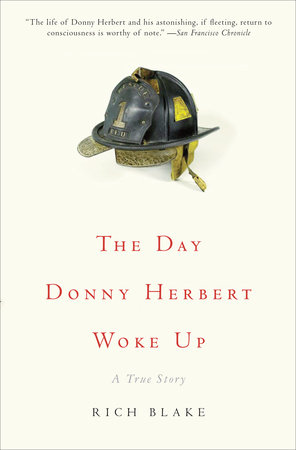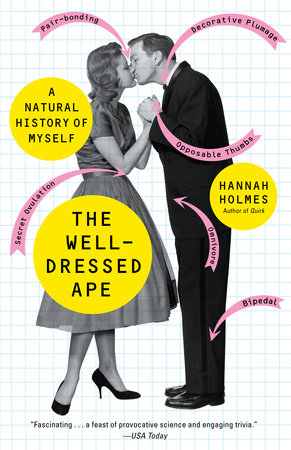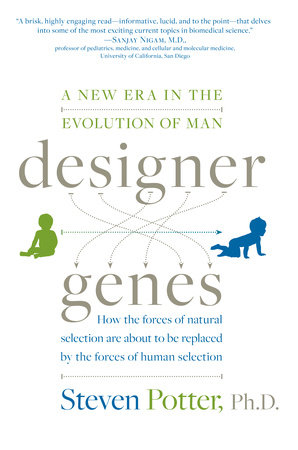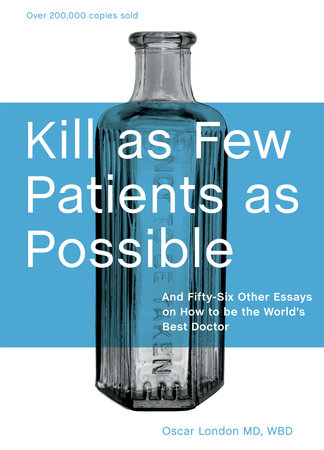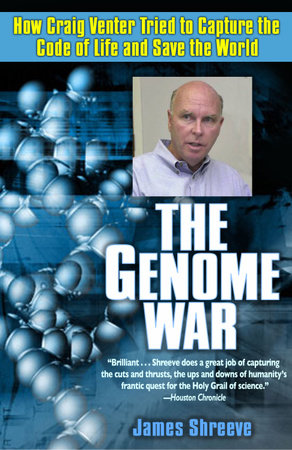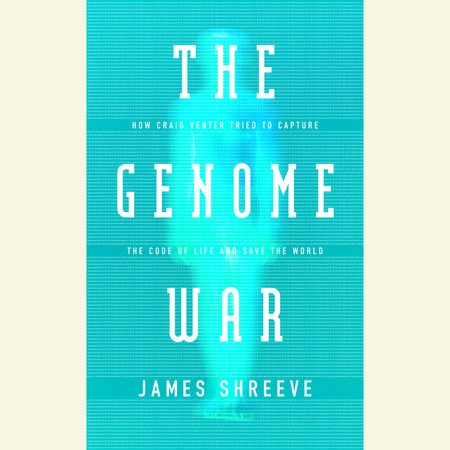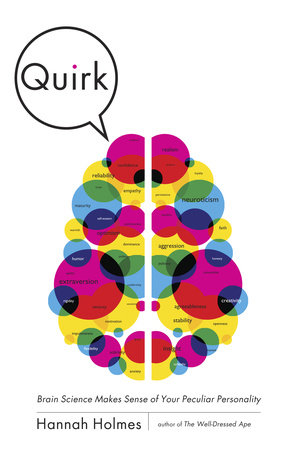Author Q&A
A Conversation with James Shreeve
Q: What drew you to the story of the race to map the human genome and when did you know that you wanted to write this book?
A: I knew I wanted to write this book from the moment I picked up the copy of the New York Times with Venter’s announcement splashed across the front page. This was early May, 1998. The government Human Genome Project had been going on for ten years. It was science on a grand scale, but it was lumbering along in a stodgy sort of way, tripping over its own internal politics and with little sense of urgency. Then Venter threw down his glove, and suddenly the same science was overflowing with tension, drama, moral conflict, rich characters, not to mention the greatness of the stakes–all the ingredients of a good story, spilling out from that single act of defiance. It was essential, however, that I be able to get up close to the action, which is why I approached Venter for access to Celera.
Q: There have been other books about the genome but this is the first look inside the race. Why is this story an important one to tell?
A: With the exception of John Sulston’s book, the treatments of the genome race so far are journalistic accounts, looking at what happened from outside and at a distance. I was after something quite different– portraying the action not as a series of historical events, but as human drama, e.g., the consequence of the protagonists’ bumping up against each others’ divergent personalities, goals and motivations. Unlike Sulston, I still wanted to provide an unbiased account — but one populated by people, not concepts. If this had been the Napoleonic War instead of the genome race, I wasn’t after a review of the great battles. I was after War and Peace. (Not that I deserve any comparison to Tolstoy!)
Q: Were you surprised by the level of access you had to Venter and his company?
A: Yes and no. Venter originally responded to my idea of doing a book with the suggestion that we collaborate on a co-authorship. His agreeing to give me access on those terms was hardly a surprise. But I only wanted to do the project if I could remain completely independent. What surprised me was how easy it was to convince him to give me the same level of access, but without any input or control over what I wrote, or even the right to see it before publication. On the other hand, he’s a very savvy guy. He could see that this was history about to happen, and an objective account of the enterprise would be a more credible reckoning than anything with his own name on it.
Q: Tell us a little about Venter and how he came to this quest.
A: Venter has phenomenal forward momentum. He thinks very quickly, and is impatient with the kind of constraints that most of us put up with so that life will proceed in a more or less orderly way– procedures, guidelines, anything that says "you can’t do this." His momentum is driven by a very urgent desire to be remembered for doing great things. A lot of successful people have that aspiration, but few of them are so explicit about it, or pursue their quest with quite the same combination of egoism and élan. Craig takes great pleasure in being Craig, and designs his life consciously to enhance that pleasure. But there is a painful edge to this too–it’s not just that he wants to achieve greatness, it’s that if he doesn’t, he feels his life will be unbearably small, amounting to nothing. So it’s not just that he’s hunting immortality, but that he’s also chased by mortality. Or perhaps those are two sides of one coin. In any case, once he had chosen biomedicine as the front on which he would play out his aspirations, attempting to sequence the human genome, or a challenge of equal grandness, was almost inevitable.
Q: You were present at some pretty intense private moments. Were there any in particular that really startled you?
A: There were a lot of exciting times, but one day in particular comes to mind, March 15, 2000. That was the day the government program made their surprise announcement that they were going to complete their draft of the genome in a year, beating Celera to the goal. Neither Venter nor anybody else at Celera had a clue this was coming, and everybody was reeling in shock. Until that day, nobody really believed the race was going to be close or even that there was a race at all. Everybody assumed the Human Genome Project was going to "stay the course" with their map-first, sequence-later approach, which simply wasn’t competitive with Celera’s shotgun method. But all of a sudden Francis Collins and company were saying they were switching gears, and would have the genome a year ahead of Celera’s projected schedule. To make the gut-punch even more painful, the government was buying their equipment for the ramp-up from Celera’s sister company. Venter had arrived that day already gasping from a case of asthma, and initially he was really panicking. But to watch him operate throughout that afternoon was amazing–handling the press, dealing with Mike Hunkapiller and Tony White, sparring with Collins on the phone, and most of all coping with the devastation wrought by the announcement among his own staff. Somehow by the end of the day, he had spun the whole thing into a new, positive fabric– it was good for Celera that the government was doing this, not bad. Quite a performance.
Watching the assembly team put the fly genome together was another high for me– there was so much at stake, so much hubris, and then this utter failure, at least initially.
Followed by triumph, which nobody outside Celera had believed possible.
Q: Okay to quickly cover the basics. What is the Genome and what does a map of it offer to the world?
A: A genome is nothing more or less than the complete genetic script for the formation of an organism–all the letters in the chemical recipe for a human being, a toad, or kumquat. The letters are made of DNA, and there are four of them, strung together in different orders just the way alphabet letters are strung together to make words. So a genome is all the words in the genetic book. Knowing their precise order is the first step toward understanding how they work together to make life happen. Defects in the code also bring about disease. So knowing the way the letters are put together is a major step forward in understanding life, and ultimately, curing disease.
Q: Venter’s idea was to make Celera "one-stop shopping for the Genomic age." What did he mean by that?
A: Think of the history of biology and medicine as an exploration further and further down into the ultimate causes of life. First scientists wanted to understand the gross anatomy of organs, nerves, senses and so on. When they invented microscopes and could see deeper, they realized these organs were composed of different tissues, and later, that the tissues were made of cells. The cells were composed of proteins, and eventually in the middle of the 20th century it was understood that the proteins were governed by genes made of DNA. The "Genomic Age" refers to a new way of looking at biology and medicine from the other direction, from the ground up–looking at all the higher levels of biological organization as the product of the interaction of genes with other genes, and genes with proteins. What Craig meant, then, was that Celera would be the place to come for all the information one would need to investigate these interactions as they reverberated up the hierarchy. Thus the company’s databases would not be limited to just the basic sequence of letters in the human genome and those of other species, but would contain information on what proteins were made from all those genes, what function they played in all sorts of different species, how much they were expressed in individual organs and systems, and so on–all the basic biological information known, gathered in one place. Sign on the dotted line, and you get the whole shebang. Or at least that was the idea.
Q: You open the book with a quote from Faust and later in the book there is a quote from Francis Collins about Venter, “He wants to be the generous scientist and at the same time the clever businessman with an obligation to his shareholders. I think he’s made a Faustian bargain and doesn’t realize it.” So do you think when all is said and done Venter did make a deal with the devil?
A: I make a lot of allusions to Faust throughout the book, and not just because both he and Venter "made a deal with the devil." Both men were gifted–or damned, depending on your point of view–with a desire to achieve noble works in their lifetime, and an impatience with the normal pace of human affairs and the limited span of mortal life. Their ambitions made them vulnerable to the lure of an outside agent–the devil in Faust’s case, private enterprise in Venter’s–who could help them achieve their goals, but at a price. The devil’s price was Faust’s soul; Perkin-Elmer’s price was simply a return on its investment. Venter thought he could more than satisfy that requirement and still set the highest idealistic standards for his science. That did not prove possible, and he did end up having to make choices based on shareholder value, just as Collins had predicted to me. Venter’s collusion with the devil of corporate America was never as deep as Collins maintained, however–as witnessed, for example, by his refusal to adopt Robert Millman’s land grab approach to intellectual property rights on the genome–ultimately it was Venter’s refusal to abide by his agreement with the "devil" that doomed Celera, at least as it was originally envisioned as a company.
Q: Why do you think that Venter inspired such hatred from his competitors and was at the same time able to draw such amazing talent to his group?
A: I asked this same question of a lot of people when I was writing the book. The
answers depended on whether the person in question was among those who hated him or were loyal to him. His critics pointed to his grandstanding, his egotism, his refusal to play by established rules, and his unapologetic pursuit of wealth. His supporters chalked up the criticism to envy, mostly–he was able to get places faster and think on a grander scale than most academics are used to. He inspired them to keep the same pace, and it was exhilarating for them. That’s how he got people to tap into their highest talents. He made it fun to do so.
Q: What is the "shotgun" method and do you think it proved the most viable way to the map?
A: "Whole genome shotgun" refers to a method of determining the complete sequence of letters in a genetic code all at once, instead of breaking it down into little sections first and working on the sections one at a time. Essentially, the DNA of an organism is blown up into tiny bits, the letters of each bit are read out on a sequencing machine, and then a gigantic computer with very powerful software stitches the bits back together, only now you know the sequence of the letters. The fact that it proved the best way to sequence a genome is borne out by the fact that virtually all genome sequencing projects now employ one form of it or another.
Q: At a certain point in this story it seems pretty clear that both Celera and the National program both begin to sacrifice science to win the race. At other times it seems that the competition fueled the scientists towards their best work. Do you think the race between these two groups hurt or helped the end result?
A: A great question without a clear-cut answer. Certainly the politics of the race interfered with the quality of the human genome both groups offered when they said their drafts were "done." But if there hadn’t been a race, there would not have been any human genome sequenced by then at all. So clearly the competition sped up the progress of the science. What would have sped it up far more, however, would have been a genuine collaboration between the two enterprises, since both lacked crucial information that the other had in abundance. So the race was better than having just the government program proceeding at its own pace, but not as good as it could have been if everyone had acted a little more nobly. But that might have been asking too much.
Q: We all know that the bottom fell out on the tech market in a devastating way. But many don’t know that as you write, “Any number of things could have triggered its collapse. It just happened to be the human genome.” Why did the genome play such a key role?
A: I really think it was a random thing–the tech market was teetering, inflated way beyond its worth, and all it took was something that would pull a single brick out of its foundation. It had to be something highly visible, however–such as the President of the United States making a speech that inadvertently took the wind out of a sector of the tech market. If he had gotten up and said "it’s not fair to the States that internet commerce is tax free," it would have had just as devastating an effect, or more so. But the President would never have made such an egregious blunder. He simply did not understand how easy it was for the market to be confused by the nuances of genomic terminology, and mistake "thou shalt now patent raw genetic material" for "thou shalt not patent genes." The fact that Venter and the genome race were already so much in the news that week probably primed the pump too. The President’s announcement was about gene patents. But all the questions from the press were about Celera and Venter.
Q: The question of patenting genes is an important part of this story. What makes a gene patentable? Isn’t it a pretty slippery slope, ethically speaking, when you get into patenting genes?
A: Wow. This is a tough one to answer in a nutshell. The first gene patent is at least twenty years old now, I think, so the first step down that slippery slope was taken a long time ago. Certainly it is ethically indefensible to patent a part of a natural living organism. I certainly wouldn’t want somebody claiming the rights to my own liver or brain, for instance, much less one of my genes. But gene patents (and protein patents, which have an even longer history) aren’t on natural living things. The correct version of the gene that when damaged causes cystic fibrosis can’t exist on its own but it can be isolated and cloned in a laboratory, and someday, perhaps, reinserted into a cystic fibrosis patient in such a manner that saves his life. Should the person who identified and isolated this gene not be allowed to profit from that discovery, if in fact the discovery has such value? If he or it, in the case of a corporation, is prevented from profiting from the discovery because the invention has a natural counterpart, what incentive is there to go after the discovery? Should somebody else profit from his invention instead? The American patent system was designed to prevent that from happening, whether the invention is a better mousetrap, butter churner, or biological product. Whether that system can be abused is another question, but one that I don’t think is specific to the biotech industry.
Q: Venter says, “The science always comes before the business . . . We can still have it both ways.” How did he plan to make money and also make his map available to the public? Do you think such a plan was doomed from the start considering Venter was
ultimately accountable to his board of directors?
A: I think Venter genuinely believed that Celera could make money even if he fulfilled his promise to make the genome public. But that depended on what was meant by "the genome." What Venter promised to offer was the basic sequence of DNA letters that make up the genetic code–if that’s all you want, he was saying, you can have it for free. But the sheer unimaginable amount of information contained in that sequence offered him the opportunity to sell what might be called "value added" products–software to help you sort through the raw sequence; other mammalian genome to compare it with, notably the mouse; protein sequences, and great scads of other biological data plucked from every other public database on the globe, reassembled in one place where it could be most efficiently used. That was the plan, at least. But it counted on Celera being the only place where such information was available, at least for the next couple of years. When the government program said that it could offer something similar within a few months, and at the extremely competitive price of zero dollars, Celera’s original business plan was indeed doomed. The only hope, perhaps, might have been the kind of all-out rush to patent that Millman was advocating–grab the genes as they come through the pipeline, so that even if they are available from the government, you can’t use them without compensating Celera. But frankly I don’t think that would have worked either. So far the only gene patents that have proved really valuable are those where the gene and its function are well understood and characterized, and have some clear application.
Q: Is this story in some sense a fable? A lesson about the merging of science and business? And if so what does it tell us?
A: Yes, I think it is a fable, in the sense that it is a story that plays out or expresses some deep, essential truth about human nature. I think that Venter honestly felt he was creating something in Celera that had never existed before–the perfect amalgamation of pure
science and business, with neither subject to the constraints normally imposed by the other. I’ve called it a scientific Camelot. But the fact is such places exist only so long as nothing
intrudes that will upset their internal balance, and human beings being human beings, something is always eventually going to intrude. But that doesn’t undermine the value of the attempt, as an inspiration for the next one, and the next one after that.
Q: What is the current status of genome research?
A: I know we now have the complete human code–the "really, really done" one celebrated last Spring. We have the mouse genome, and the dog–Venter’s dog Shadow, in fact, supplied the DNA–and a host of microbial genome that are helping us understand the global environment. Genome projects important for agriculture are completed or underway, such as the corn genome and cow genome. We have identified several new genes important to medicine recently, including the gene responsible for osteoporosis, announced a couple of weeks ago by a company in Iceland. So things are progressing. But there hasn’t been the "great leap forward" yet predicted to follow the completion of the code.
Q: What is Venter up to these days and what do you think he will think of the book?
A: Venter is still trying to do great things. He is very deeply involved in what is being called "environmental genomics"–not just sequencing individual genome, but delving into environments to see what sort of microbial life is there that can only be discerned by the presence of its code in a beaker of water or test-tube of soil. From 200 liters of sea-water in the Sargasso Sea, for instance, his group at the Institute for Biological Alternatives has found thousands of new species and more than one million new protein-coding genes–about 10 times the total number of genes discovered to date. "The new genes include hundreds of new photoreceptors that capture energy from sunlight," he says." If the same extent of microbial diversity exists across the oceans, it is not
inconceivable that hundreds of millions of genes could be discovered." If that does not seem sensational enough, consider that one of the other projects underway at the Institute is an attempt to create a new microbial life form from scratch that is engineered to convert greenhouse gases into combustible fuel. Conjuring up new life forms that feed on pollution to create new energy is certainly an alchemy worthy of Faust himself.
As for what he’ll think of the book–I hope he likes it, but not too much.





